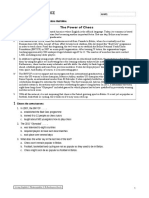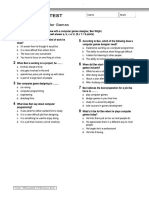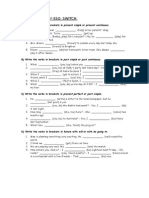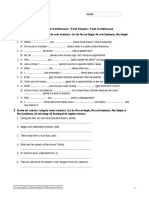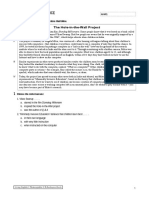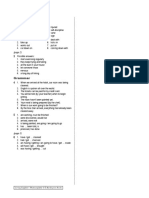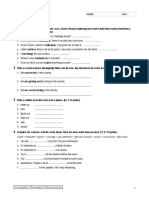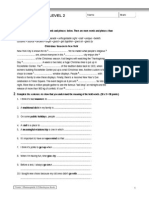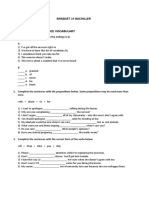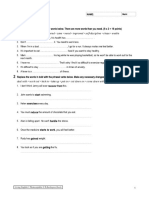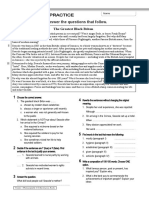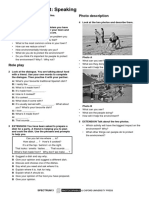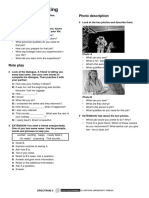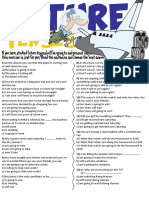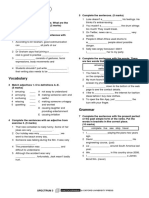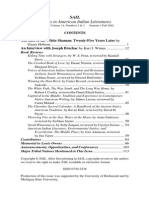Trends1 Aio Eep7
Trends1 Aio Eep7
Uploaded by
TTNLittleGeniusCopyright:
Available Formats
Trends1 Aio Eep7
Trends1 Aio Eep7
Uploaded by
TTNLittleGeniusOriginal Description:
Copyright
Available Formats
Share this document
Did you find this document useful?
Is this content inappropriate?
Copyright:
Available Formats
Trends1 Aio Eep7
Trends1 Aio Eep7
Uploaded by
TTNLittleGeniusCopyright:
Available Formats
7 EXTRA EXAM PRACTICE
Name
Read the text and answer the questions that follow.
Secret Writing
I People have always wanted to communicate secretly: children, lovers, diplomats and spies need to send undetectable
messages, so it’s not surprising that many ways of doing this have developed.
II In 2000 BC, few people could read, so sending a written message to another literate person almost guaranteed secrecy.
Later on, attempts at concealment included the use of invisible inks, or, for example, this method used by Ancient Greeks
in about 400 BC: they shaved a slave’s head, tattooed a message on his bare scalp, and sent him to deliver the message
when his hair had grown back. Meanwhile, Ancient Spartans wrote messages on pieces of cloth wrapped around a stick.
The cloth was then unwound and the message could only be read if it was rewrapped on a stick of exactly the same
diameter.
III Later on, people began to experiment with codes, substituting one symbol for another. One early substitution code was
developed by Julius Caesar, who moved each letter three places backwards, turning D into A, E into B, and so on.
According to this code, the word ‘hello’ appears as ‘ebiil’.
IV Eventually, cryptography (meaning secret writing in Greek) included special devices to encode and decode messages.
Other methods used a “key”, a written work known to the sender and receiver but not to others. These keys, however, had
to be carefully guarded from falling into the wrong hands. During World War I, the British recovered code books from
destroyed German submarines and aeroplanes. By World War II, the Germans were coating these books in lead, ensuring
that they would sink rather than be recovered by the enemy. In the same war, the United States Marine Corps used about
500 “code talkers”, Native American Indians who passed on messages and information using languages like Navajo,
which were incomprehensible to Europeans.
V The invention of computers in the 20th century revolutionised cryptology. In the 1970s, the IBM corporation created a
code known as DES. It took 20 years and thousands of people to crack the code! But for now, see if you can crack this:
qeb bka!
1 Choose the correct answer.
1. In about 400 BC ...... .
4 Rewrite the sentences without changing the original
meaning.
a. Greek slaves were required to shave a
1. People experimented with codes, substituting
messenger’s head
one symbol for another.
b. Greek slave’s hair sometimes hid a secret message
People experimented with codes which .................
c. Spartans had to unwrap a cloth to read their
................................................................................ .
messages
2. These keys must be guarded from falling into the
2. The Germans ...... .
wrong hands.
a. rescued their code books from destroyed planes
These keys can’t be allowed ...................................
b. recovered copies of their code books from British
................................................................................ .
submarines
c. preferred their code books to sink rather than fall 5 Find words or expressions in the text that mean the
into British hands following:
2 Decide if the sentences are T (true) or F (false). 1. material (paragraph II) ............................
Find evidence in the text to justify your answers. 2. covering (paragraph IV) ............................
...... 1. Code talkers taught marines to speak their 3. guaranteeing (paragraph IV) ............................
Native American languages. 4. transmitted (paragraph IV) ............................
...................................................................... 5. radically changed (paragraph V) ............................
...... 2. Computers can create complicated codes.
6 Write a composition of 100-150 words. Choose ONE
...................................................................... option.
3 Answer the question. 1. Have you ever used a method of secret
communication? Describe the method and the
What were two of the earliest methods of secret
situation in which it was used.
communication?
.....................................................................................
7 EXTRA EXAM PRACTICE
2. The world would be a better place if people were
always open and honest with each other. Do you
agree or disagree? Give your reasons.
You might also like
- Navajo Code TalkersDocument14 pagesNavajo Code Talkerstiger.wu.25031No ratings yet
- Code Talker Guided Reading Questions PDFDocument2 pagesCode Talker Guided Reading Questions PDFmrsnordstrom60% (5)
- Unit 6 Self TestDocument3 pagesUnit 6 Self TestFonsi Arc Rs100% (4)
- Trends1 Aio Ut1-L1Document2 pagesTrends1 Aio Ut1-L1Yolanda Csp77% (13)
- Trends1 Aio Ut2-L1Document2 pagesTrends1 Aio Ut2-L1Yolanda Csp75% (8)
- 3 Extra Exam Practice: CrowdsourcingDocument2 pages3 Extra Exam Practice: CrowdsourcingAna PCid100% (1)
- LE1 Test U3 ReadingDocument2 pagesLE1 Test U3 ReadingBelén Atalaya50% (12)
- 2 Extra Exam Practice: The Power of ChessDocument2 pages2 Extra Exam Practice: The Power of ChessAna PCid0% (1)
- LE1 Test U6 2Document2 pagesLE1 Test U6 2Liliana Amp100% (5)
- Unit 8 Self TestDocument2 pagesUnit 8 Self TestFonsi Arc Rs100% (1)
- Trends 1Document4 pagesTrends 1belendi67% (3)
- Unit 3 Self TestDocument2 pagesUnit 3 Self Testjose63% (8)
- Examenes 4 EsoDocument17 pagesExamenes 4 EsoNoemí Martínez Delgado0% (1)
- Listening Test 1. Trends 1Document1 pageListening Test 1. Trends 1Yolanda Csp100% (2)
- Vocabulary and Grammar Answer Key: Extension 1Document6 pagesVocabulary and Grammar Answer Key: Extension 1TTNLittleGenius100% (2)
- English Test, 4º EsoDocument2 pagesEnglish Test, 4º Esono hay nada73% (11)
- LE1 Test U6 ReadingDocument2 pagesLE1 Test U6 ReadingLiliana Amp20% (5)
- LE2 AIO S RevisionDocument8 pagesLE2 AIO S RevisionLoli Garcia Vargas100% (3)
- 5 Unit Test: Optional ReadingDocument2 pages5 Unit Test: Optional ReadingJose Alberto Garcia SanchezNo ratings yet
- Vocabulary and Grammar Answer Key: Extension 1Document6 pagesVocabulary and Grammar Answer Key: Extension 1TTNLittleGenius100% (2)
- Spectrum TRD3 Tests Diagnostic PDFDocument4 pagesSpectrum TRD3 Tests Diagnostic PDFTTNLittleGeniusNo ratings yet
- Future Simple Future Continuous and Future Perfect 67499Document2 pagesFuture Simple Future Continuous and Future Perfect 67499TTNLittleGenius50% (2)
- Diagnostic 2018 Petersons ACT Prep GuideDocument102 pagesDiagnostic 2018 Petersons ACT Prep GuideminwhanrieuNo ratings yet
- Le1 Aio Ut1Document2 pagesLe1 Aio Ut1Loli Garcia Vargas100% (2)
- Trends1 Aio VG Ex1Document4 pagesTrends1 Aio VG Ex1Yolanda Csp100% (2)
- 4 Extra Exam Practice: The Hole-in-the-Wall ProjectDocument2 pages4 Extra Exam Practice: The Hole-in-the-Wall ProjectAna PCidNo ratings yet
- Trends1 Test U5 ReadingDocument2 pagesTrends1 Test U5 ReadingLiliana AmpNo ratings yet
- Trends1 Aio Ut5 Ak PDFDocument1 pageTrends1 Aio Ut5 Ak PDFFran CamposNo ratings yet
- Unit 5 Self Test ANSWERSDocument1 pageUnit 5 Self Test ANSWERSFernando Lopez SanchezNo ratings yet
- Trends1 Aio Eep AkDocument2 pagesTrends1 Aio Eep AkTTNLittleGenius50% (2)
- Trends1 Aio VG Ex4Document3 pagesTrends1 Aio VG Ex4Jccd JccdNo ratings yet
- Trends1 Aio VG Mp1Document4 pagesTrends1 Aio VG Mp1alNo ratings yet
- LE1 Test U6 1Document3 pagesLE1 Test U6 1minoro2583No ratings yet
- Trends Test 1 Unidad 8Document2 pagesTrends Test 1 Unidad 8sesnake9983% (6)
- Trends1 Aio Eep1Document1 pageTrends1 Aio Eep1Yolanda Csp100% (1)
- Reading Test Unit 2Document4 pagesReading Test Unit 2Nuria Diaz GomezNo ratings yet
- Exam Extra Practice TrendDocument2 pagesExam Extra Practice TrendTTNLittleGenius0% (1)
- Trends1 Test U5 2Document2 pagesTrends1 Test U5 2Liliana Amp50% (2)
- Listening 1º Unit 4Document1 pageListening 1º Unit 4veronicaNo ratings yet
- WayToEng4 EP 2-2Document3 pagesWayToEng4 EP 2-2veronicaNo ratings yet
- Final Examen SoniDocument4 pagesFinal Examen SoniSonia Daniela Ayuso Frutos0% (1)
- Trends1 Aio Ut4 AkDocument1 pageTrends1 Aio Ut4 AkTTNLittleGenius100% (1)
- Trends2 Aio VG Ex2Document4 pagesTrends2 Aio VG Ex2TTNLittleGeniusNo ratings yet
- Unit 1 More PracticeDocument4 pagesUnit 1 More PracticeJosefina LopezNo ratings yet
- Action1 Test U7 2Document4 pagesAction1 Test U7 2RobertoPerezConde100% (2)
- Trends2 Aio Ut1 AkDocument2 pagesTrends2 Aio Ut1 AkAnonymous QO95s8zX100% (1)
- Le1 Aio Pretest AkDocument1 pageLe1 Aio Pretest AkLoli Garcia Vargas100% (1)
- 3 More Practice: VocabularyDocument4 pages3 More Practice: VocabularyLauraNo ratings yet
- Unit 5 Self TestDocument3 pagesUnit 5 Self TestRocio Saucedo100% (1)
- Follow - Referee - Notice - Lifeguard - Court - Defeat - Hide - Refuse - Position - SinkDocument3 pagesFollow - Referee - Notice - Lifeguard - Court - Defeat - Hide - Refuse - Position - SinkMaríaRodríguezMartínNo ratings yet
- 3 Unit Test: VocabularyDocument2 pages3 Unit Test: VocabularyBart Simpsons FernándezNo ratings yet
- Trends1 Aio VG Mp1Document4 pagesTrends1 Aio VG Mp1Yolanda CspNo ratings yet
- Term 1 Revision Exercises Eso 3 Way To EnglishDocument4 pagesTerm 1 Revision Exercises Eso 3 Way To EnglishVane Yeste100% (1)
- Trends1 Aio Eep7Document1 pageTrends1 Aio Eep7nayara Martin PovedaNo ratings yet
- Trends1 Aio Eep3Document1 pageTrends1 Aio Eep3Bart Simpsons FernándezNo ratings yet
- Módulo 3 - 2do Inglés Técnica - FOR ME - 2023Document22 pagesMódulo 3 - 2do Inglés Técnica - FOR ME - 2023agustinadelosangelesfazioNo ratings yet
- Reading and Writing HandoutDocument3 pagesReading and Writing HandoutTakka MoussaNo ratings yet
- Prime Time TRP Mod 3Document12 pagesPrime Time TRP Mod 3pauline barauskaitieneNo ratings yet
- Past - ActivityDocument12 pagesPast - ActivityPaola Fernández CastelNo ratings yet
- Defining and Non-Defining Relative ClausesDocument12 pagesDefining and Non-Defining Relative Clauseskapel Jr.No ratings yet
- The Invention of GunpowderDocument5 pagesThe Invention of Gunpowderisrael torrezalvaradoNo ratings yet
- South 24 Parganas GovtDocument5 pagesSouth 24 Parganas Govtfarhan0123456rashidNo ratings yet
- Reading and Writing HandoutDocument3 pagesReading and Writing HandoutBouteina NakibNo ratings yet
- Mid Term Final VersionDocument10 pagesMid Term Final VersionAle FunesNo ratings yet
- Reading Comprehension 1 - The Emperor's New ClothesDocument8 pagesReading Comprehension 1 - The Emperor's New ClothesLacel TolentinoNo ratings yet
- The Emperors New ClothesDocument12 pagesThe Emperors New ClothesAtina GarciaNo ratings yet
- Trends2 Aio VG Ex2Document4 pagesTrends2 Aio VG Ex2TTNLittleGeniusNo ratings yet
- Trends2 Aio VG Ex1Document4 pagesTrends2 Aio VG Ex1TTNLittleGeniusNo ratings yet
- Trends1 Aio Eep AkDocument2 pagesTrends1 Aio Eep AkTTNLittleGenius50% (2)
- Trends1 Aio Ut4 AkDocument1 pageTrends1 Aio Ut4 AkTTNLittleGenius100% (1)
- Trends1 Aio Eep1Document1 pageTrends1 Aio Eep1Yolanda Csp100% (1)
- Exam Extra Practice TrendDocument2 pagesExam Extra Practice TrendTTNLittleGenius0% (1)
- Trends1 Aio Eep1Document1 pageTrends1 Aio Eep1Yolanda Csp100% (1)
- Spectrum TRD3 Tests EOT2 SpeakingDocument1 pageSpectrum TRD3 Tests EOT2 SpeakingTTNLittleGeniusNo ratings yet
- Spectrum TRD3 Tests Unit1 SpeakingDocument1 pageSpectrum TRD3 Tests Unit1 SpeakingTTNLittleGenius100% (1)
- Spectrum TRD3 Tests Unit6 SpeakingDocument1 pageSpectrum TRD3 Tests Unit6 SpeakingTTNLittleGeniusNo ratings yet
- Unit 9 Test: Speaking: Photo DescriptionDocument1 pageUnit 9 Test: Speaking: Photo DescriptionTTNLittleGeniusNo ratings yet
- Spectrum TRD3 Tests Unit1 SpeakingDocument1 pageSpectrum TRD3 Tests Unit1 SpeakingTTNLittleGenius100% (1)
- Spectrum TRD3 Tests Unit1 SpeakingDocument1 pageSpectrum TRD3 Tests Unit1 SpeakingTTNLittleGeniusNo ratings yet
- SpectrumDocument1 pageSpectrumTTNLittleGeniusNo ratings yet
- Spectrum TRD3 Tests EOT1 1Document4 pagesSpectrum TRD3 Tests EOT1 1TTNLittleGeniusNo ratings yet
- Cambridge English Preliminary For Schools Teachers HandbookDocument4 pagesCambridge English Preliminary For Schools Teachers HandbookGeorgiana PopaNo ratings yet
- Cuadro TensesDocument3 pagesCuadro TensesTTNLittleGeniusNo ratings yet
- Other Reporting VerbsDocument2 pagesOther Reporting VerbsAnonymous 5z9WjiNo ratings yet
- NewAction3 AIO UT1-ListenSpeakDocument1 pageNewAction3 AIO UT1-ListenSpeakTTNLittleGeniusNo ratings yet
- Future Tenses Exerciseswillbe Going To and Present 79612Document2 pagesFuture Tenses Exerciseswillbe Going To and Present 79612TTNLittleGenius33% (3)
- Trends1 Aio Eep AkDocument2 pagesTrends1 Aio Eep AkTTNLittleGenius50% (2)
- Spectrum TRD3 Tests Unit4 2Document4 pagesSpectrum TRD3 Tests Unit4 2TTNLittleGenius100% (2)
- Adjetivos Compuestos en Inglés b2Document3 pagesAdjetivos Compuestos en Inglés b2TTNLittleGeniusNo ratings yet
- Know The News: The Code That Couldn't Be Broken: Test PrepDocument1 pageKnow The News: The Code That Couldn't Be Broken: Test PrepLeticia LobiancoNo ratings yet
- Ghs Teks of ConcernDocument17 pagesGhs Teks of Concernapi-254968708No ratings yet
- Lighthouse Dec. 9, 2010Document40 pagesLighthouse Dec. 9, 2010VCStarNo ratings yet
- Code TalkerDocument59 pagesCode TalkertedwardsNo ratings yet
- The Navajo Code TalkersDocument2 pagesThe Navajo Code Talkerscaotri900No ratings yet
- Native American Society JMHS American HistoryDocument7 pagesNative American Society JMHS American HistorykzhbmgnmhjNo ratings yet
- Trends1 Aio Eep7Document2 pagesTrends1 Aio Eep7TTNLittleGeniusNo ratings yet
- Nct-Avery DoumaDocument4 pagesNct-Avery DoumaAvery DoumaNo ratings yet
- The Rise of White ShamansDocument119 pagesThe Rise of White ShamansMichal Golis100% (1)
- Code Talker by Joseph BruchacDocument6 pagesCode Talker by Joseph BruchactedwardsNo ratings yet
- Code Talkers Journey BoxDocument26 pagesCode Talkers Journey Boxapi-479648192No ratings yet
- World War II WebquestDocument19 pagesWorld War II WebquestTomás Monzón100% (9)
- U.S. National Intelligence - An Overview, 2013Document103 pagesU.S. National Intelligence - An Overview, 2013Office of the Director of National Intelligence100% (11)
- Jessica Williams CKP Final DraftDocument9 pagesJessica Williams CKP Final Draftapi-294407944No ratings yet
- Ntrance XAM Arch: Instituto de Enseñanza Superior en Lenguas Vivas "J. R. Fernández"Document7 pagesNtrance XAM Arch: Instituto de Enseñanza Superior en Lenguas Vivas "J. R. Fernández"Valentina PolicaroNo ratings yet
- 304 Navajo Code Talkers - Motivations JstorDocument3 pages304 Navajo Code Talkers - Motivations Jstorapi-285170514No ratings yet
- Context CluesDocument0 pagesContext Clueswakdoj6345No ratings yet
- Speaking Change How The Navajo Code Talkers Broke Racial Stereotypes and Helped The UDocument7 pagesSpeaking Change How The Navajo Code Talkers Broke Racial Stereotypes and Helped The Uapi-745866322No ratings yet
- Secret Code TalkersDocument2 pagesSecret Code TalkersKris Avein MalaayNo ratings yet
- Ghs Teks of ConcernDocument24 pagesGhs Teks of Concernapi-254968708No ratings yet
- Is Revenge Worth The Cost?: 9-12 Grade The Atomic Bomb Inquiry by Chuck UllestadDocument33 pagesIs Revenge Worth The Cost?: 9-12 Grade The Atomic Bomb Inquiry by Chuck UllestadOlivia CaffreyNo ratings yet







